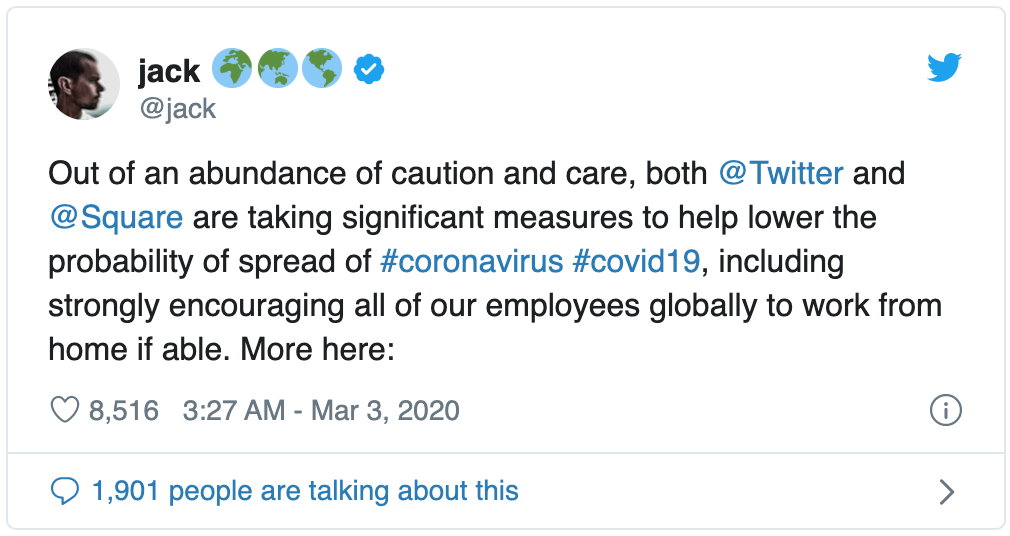Arbejdet under pandemien: Teknologi til virksomheder i tider med Corona
30. marts 2020

While we don’t know much about how Covid-19 will change the world we live in, one thing seems abundantly clear: social distancing and social isolation are our best guesses for slowing down this virus, thus saving lives.
While not everyone can work from home, most companies that have the option have allowed or even forced their staff to work remotely. Luckily, many of the jobs in the digital age don’t require much more than a laptop, electricity and wifi. But it’s not as easy as sending everyone off with their Macbooks and hoping for business to continue as usual.

So how do you keep up morale and the company culture going while everyone is sitting at home with a pantry full of pasta, worrying about their elderly family members, with an antsy child that should be in kindergarten?
In addition to finding ways to deal with social isolation today, businesses need to think ahead.
Because scientists agree: Covid-19 isn’t the last pandemic we will see. With modern society spreading and the planet heating up, outbreaks will be more and more common.
Home office measures to take today
If your staff still works from the office, be prepared to have everyone working from home soon. Here are some low-hanging fruits of things to implement today.
1. Make sure everyone has the hardware they need.
This might mean allowing your employees to put a couple extra purchases on a company credit card. Not everyone is set up to work from home. In order to keep productivity up, consider allowing for purchases like an additional screen. Though this is hopefully all temporary, “tech neck” should be avoided. Ergonomic solutions are the sustainable choice.
2. Compile and publish work from home guidelines.
And that doesn’t have to be an extensive document. But laying down some ground rules on communication and availability as well as setting expectations helps your employees to build a basic work from home structure.
3. Combat social isolation by coffee chat roulette or other fun games.
Going to work isn’t just about creating value for the business. We usually see our colleagues more than our families and closest friends. If that part of your social life is suddenly cut out, potentially alongside most other social interactions, humans suffer mentally.
As social animals, we don’t do well in isolation. To lessen the burden, think about matching random employees up for a virtual coffee date! Or you could set up a group chat where people can discuss their quarantine meal ideas or favorite shows on Netflix. Anything that helps to feel more connected.

How to prepare for home office in the future with the right technology and processes
Successfully preparing for extended home office periods includes two aspects:
- Physical preparation (hardware, software, tools)
- Mental preparation (mindset, motivation, communication skills, etc.)
We’ll shine some light on both of those areas. Please be aware that there is no one-size-fits-all solution here. For instance, if your business deals with highly sensitive data (such as healthcare companies or governmental organizations), some of the strategies and tools mentioned simply will not work for you.
Hardware essentials for home office
Luckily, we don’t have to make this bit more complicated than it needs to be. First of all: ask your employees what they need to do their best work. Some like to use ergonomic external keyboards, others are fine to type away on their laptops.
Smaller items should be taken home from the office in situations like the Corona lockdown. Larger items like additional screens might need to be purchased additionally.
To allow for productive remote work, communication must be on par. That only works with:
- a good webcam and
- great audio solutions
- forward-thinking conference solutions.
Not all businesses have managed to send their entire staff home
In some cases, certain groups of employees still need to come into the office. An agency in Berlin for instance still requires their finance team and all employees in leadership positions to physically show up at the office every day.
In cases like that, conference solutions matter more than ever. To connect with their teams at home for instance, the leadership team at that agency needs stable, reliable and innovative hardware solutions like the Sennheiser TeamConnect Ceiling 2 ceiling microphone.
The upside of having a select group of people still at the office: at least they still have access to whiteboards, large screens, projectors, etc. Thus, meetings can be made more efficient that when everyone is sitting in front of a tiny 13" screen.
If your business still has staff at the office premises, some ideas to stop Covid-19 outbreaks include:
- Give everyone working from the office a seperate room and bathroom, if possible.
- Be sure to disinfect basically everything all the time (door handles, microphones, elevator buttons, etc. Especially plastic and steel surfaces need extra attention).
- Put up some signs reminding your employees to take extra precautions, for instance when washing their hands.

The right software and tools for remote work
In addition to your usual software-needs, you need to step up your communication game. Tools like Slack and Zoom (or Skype for Business / GoToMeeting / etc.) are no longer optional. There should be solutions in place for these five types of communication:
- Online-Meetings, either 1:1 or in larger groups. For remote company-wide meetings, it’s important that participants can be muted, can raise their hands for votes and ask questions through a chat.
- Written communication “on the go”. Email isn’t ideal here, since it misses the chat-feeling that excellerates speed. Make sure your tool of choice allows you to @-mention team mates and send push notifications.
- Long-form written communication like email.
- Documentation and collaborative documents, such as an internal wiki (for instance with Confluence) or shared documents on Google Drive or SharePoint.
- Project and task management software like Jira, Trello, or Monday so people can inform each other of tasks they need help with and plan projects.
In addition to the business tasks at hand, communication tools that make it easy to connect will also help with the mental burden of being locked away alone.
In addition to these absolute “must haves”, here are some optional measures to consider:
- Set up a VPN to protect your sensitive data.
- Implement productivity tools such as Freedom to allow employees to block certain types of websites during the day.
- If you’re not tracking KPIs already, start now. That way, everyone knows what is expected of them and you can check up on how your team is doing even if they are not physically together. Examples for KPIs could be tickets solved, calls made, or tasks finished.
Mindset, motivation and communication skills your team needs during quarantine
To be quite honest, it is very hard to predict how several weeks of quarantine and social isolation will impact the mental health and productivity of workers. This is the first pandemic of the digital world.
However, a couple things can be predicted.
- While teleworkers tend to be more productive than their colleagues at the office, the long-term quarantine with limited access to sports, fresh air and social contacts, will probably make us all less productive.
- For companies that aren’t used to working from home, communication will be challenging.
- Setting boundaries and sticking to working hours will get increasingly difficult when children stay home due to closed schools and kindergartens.
Tips to stay productive during lockdown
When looking for tips and tricks to stay motivated while working from home, all we can do is look to seasoned teleworkers and freelancers for advice.
Some common advice from experiences remote workers includes:
- Get dressed in the morning, even if you know you won’t leave the house. You need to still take yourself and your work seriously.
- Overcommunicate, to avoid information being lost at all cost. It’s better to send a couple of unnecessary messages than to forget one.
- Set up a dedicated work space and make it clear to those around you that you need your time to focus.
- Don’t expect to work productively for eight hours a day. Nobody does. Take it easy and work when you feel productive. 90 minutes are a good focus-time after which it is definitely time for a break. For some people, the Pomodoro Technique works wonders.
- Try to limit distractions like Netflix, social media, and news sites.
- Set up habits that help you to be productive. That takes some time, since you first have to get to know yourself better and find out what works for you. For instance, some people find it helpful to do their dishes when they are stuck on a work problem, because it shifts the focus. Others really enjoy power naps in the afternoon. At home, there is room to explore and experiment!
How to support your team
To support your team in sticking to these general guidelines, you can set up daily virtual standup meetings, help them with any questions they have regarding their remote work routine, and potentially even work on trainings to roll out during lockdown.
Working from home requires a different mindset than working from an office. The quicker your team learns that, and the more people support each other, the better your chances..

In conclusion – keep calm!
If your employees sit at home and are equipped with the right hardware, software and resources, you’re halfway there. Make sure everyone knows what is expected of them and keep the communication as active and easy as possible. We will need a lot of virtual contact with others during these trying times.
And see this as a learning opportunity. When this thing is over, when we can hang out again and share after work beers, we will be a whole lot wiser and know exactly what it takes to keep a business running – even through quarantine


